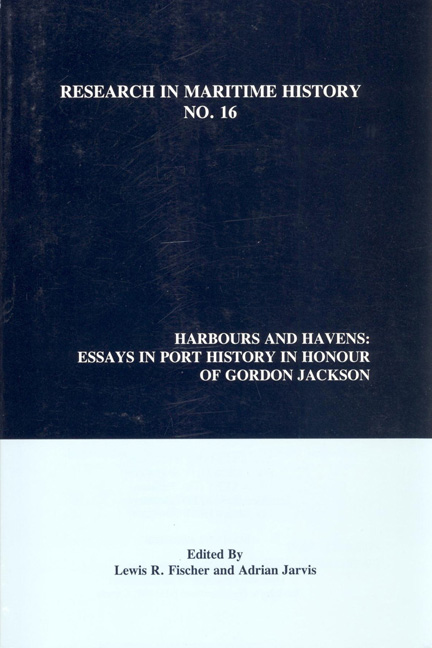Book contents
- Frontmatter
- Contents
- About the Editors
- Contributors
- Introduction
- “Gordon Jackson: An Appreciation”
- “Port History: Some Thoughts on Where it Came from and Where it Might be Going”
- “Port Politics: Interest, Faction and Port Management in Mid-Victorian Liverpool”
- “Our Little Company:' The Wilsons and North Eastern Railway Shipping Company Limited, 1906-1935”
- “The Changing Functions of a Rural Port: Dumfries, 1700-1850”
- “Australian Ports Since 1945”
- “Aspinall, Cornes and Company and the Early Development of the Port of Yokohama”
- “Dubai: From Creek to Global Port City”
- “New York's German Suburb: The Creation of the Port of Bremerhaven, 1827-1918”
- “Capital and Labour in the Port Town of Esbjerg, 1945- 1999”
- “Port Policies: Seaport Planning around the North Atlantic, 1850-1939”
- “Gordon Jackson: A Bibliography”
“Australian Ports Since 1945”
- Frontmatter
- Contents
- About the Editors
- Contributors
- Introduction
- “Gordon Jackson: An Appreciation”
- “Port History: Some Thoughts on Where it Came from and Where it Might be Going”
- “Port Politics: Interest, Faction and Port Management in Mid-Victorian Liverpool”
- “Our Little Company:' The Wilsons and North Eastern Railway Shipping Company Limited, 1906-1935”
- “The Changing Functions of a Rural Port: Dumfries, 1700-1850”
- “Australian Ports Since 1945”
- “Aspinall, Cornes and Company and the Early Development of the Port of Yokohama”
- “Dubai: From Creek to Global Port City”
- “New York's German Suburb: The Creation of the Port of Bremerhaven, 1827-1918”
- “Capital and Labour in the Port Town of Esbjerg, 1945- 1999”
- “Port Policies: Seaport Planning around the North Atlantic, 1850-1939”
- “Gordon Jackson: A Bibliography”
Summary
Introduction
Since the arrival of the First Fleet in 1788, ports have provided vital gateways for Australian shipping and trade. The vast size of the country, with its widely-separated centres of population concentrated along the coast, has meant that both coastal and overseas shipping have been important consumers of port services. In the late 1990s Australia had about eighty ports, ranging from minor ones designed primarily to serve the needs of local communities, the fishing industry or recreational boating, to specialised bulk-handling and major commercial hubs. Together, such ports handled ninety-nine percent of Australia's international cargo by volume and seventy-four percent by value. In 1995/1996 international trade at Australian ports totalled 420 million tonnes worth AUS $115,770 million. To remain efficient interfaces between land and sea transport, after 1945 the ports were forced to adjust to major changes in trade, shipping and cargo-handling technology. The technological changes were part of a worldwide revolution, the major features of which were the exploitation of the economies of scale from increased ship size and the extension of mechanisation to the handling of general cargo.
In many respects, the movement of cargo fifty metres across a wharf is as important as its carriage 1000 kilometres by sea. While goods must be kept flowing at a steady rate if cargo handling is not to become a costly and tortuous process, Australia's ports over the years have achieved a relatively poor reputation for speed of turnround, industrial disputes and restrictive work practices. Since the Second World War, governments have been involved in numerous attempts to restructure the industry, a task made more difficult by the diverse elements involved and the sometimes dismal climate of labour relations on the waterfront. Since the late 1980s the ports have been the targets of on-going and sometimes controversial reforms which have had a major impact on efficiency. The early months of 1998 were dominated by a struggle between government, employers and the Maritime Union of Australia (MUA) over the use of non-union labour on the wharves.
Gordon Jackson, in whose honour this chapter is written, has observed that “ports are living organisms” that must adapt if they are to prosper and grow. The aim of this essay is to survey the spectacular shifts that have occurred in Australian ports since 1945 and to evaluate their success in adapting to changes in the scale and nature of port activity.
- Type
- Chapter
- Information
- Harbours and HavensEssays In Port History In Honour Of Gordon Jackson, pp. 111 - 138Publisher: Liverpool University PressPrint publication year: 1998

